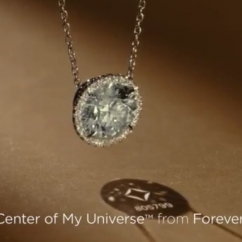Articles and News
DE BEERS EXECS: PLANS TO TRANSFORM FROM MINING TO LUXURY COMPANY, BUT NO FIGURES FOR FOREVERMARK | January 09, 2013 (0 comments)

Also: A machine to screen for synthetics, and a potential industry credit crisis
New York, NY—For the first time since 1948, De Beers is again allowed to do business in the United States. The company earlier this year paid $295 million to settle long-term antitrust lawsuits that kept it from directly buying, selling, or marketing here, and now De Beers says it has big plans for increasing its Forevermark brand in the United States.
In their first official business appearance, De Beers’ top executives on Tuesday addressed an open meeting of the Diamond Manufacturers and Importers Association of America. Philippe Mellier, CEO of the De Beers Group discussed the company’s long-term strategy for transforming itself from a mining company to a luxury company. Varda Shine, executive vice president of global sightholder sales, addressed issues of ethics and sustainability, and Stephen Lussier, who holds the joint title of executive vice president of marketing for the Group and CEO of its Forevermark brand, addressed plans for marketing the brand and diamonds in general.
From a mining company to a luxury company. “Diamonds are not a commodity,” emphasized Mellier. “Diamonds are part of the luxury world, and the luxury world is consumer-driven. Diamonds have to be customer-driven.” This is an about-face approach from that of a typical mining company, which is supply-driven. De Beers, he says, wants to understand what the consumer wants today, and what the consumer will want tomorrow, and to fully understand consumer preferences and tastes—which will drive its mining decisions. He cited the firm’s investment in both the Forevermark and De Beers Diamond Jewellery retail store brands as ways to help accomplish that goal.
In terms of mining itself, De Beers’ association with Anglo-American (also a leading producer of gold and platinum) will help boost exploration. “It’s a challenge to find the next big mine. We’re working on multiple smaller projects,” he said with regard to future supply.
What's ahead for Forevermark. In a private discussion prior to his address, Stephen Lussier told The Centurion that the Forevermark brand had “very good” holiday sell-through. Hard data is not yet available, he said, but anecdotal evidence has been very positive, and he attributes it to the brand’s decision to run a television schedule for its first “Center of My Universe” commercial.
“Our web traffic leapt 10 times after the TV commercial aired,” he said, prompting some customers to drive as much as three hours to the nearest Forevermark jeweler. He later regaled the audience with the tale of a customer in Texas who did just that because his wife specifically requested the necklace featured in the commercial for a Christmas present.
“We will absolutely continue TV!” emphasized Lussier, acknowledging it was the key driver of the brand’s sell-through this year.
Forevermark retail jeweler partners should be very relieved to hear his pronouncement. They were highly—and sometimes vocally—disappointed in the lack of a commercial in 2011. The brand’s initial plans for Q4 2012 called for online-only distribution of a commercial, but were quickly amended to include TV.
In his general address, Lussier discussed De Beers’ strategic focus on the emotional equity of diamonds, and the need to market them based on their emotional appeal. He called it the “Diamond Dream.”



From left, Philippe Mellier, Varda Shine, and Stephen Lussier
Ironically, he said, in the 1930s, Harry Oppenheimer had to persuade the De Beers board that the consumer demand curve could be influenced. Their belief was that if a luxury product had to be marketed, it wasn’t luxury. Today, he said, it’s all in the marketing: Gucci, LVMH, Hermes, all have achieved success through it, and De Beers has successfully attached diamonds as a universal symbol of emotion. He cited figures showing how both the USA and Japan went from little or no market penetration of the diamond engagement ring to more than three-fourths of all first time brides receiving one.
“There are lots of luxury products to spend money on, but no other conveys emotion, both publicly and privately, like diamonds. A handbag isn’t going to do it,” he said. He also addressed a strategy to position diamonds as “eternally elegant,” not a fashion that goes in or out, and as a perception of lasting value.
“Don’t do it as an investment to sell two years from now, but still it’s nice to know that diamonds will appreciate in value in the long term,” he said.
But exactly how will De Beers influence consumer demand? While the executives’ presentation clearly spelled out the need to market diamonds as a luxury product, it stopped well short of taking on that responsibility itself.
DMIA president Ronald J. Friedman asked about plans to revive the generic diamond advertising De Beers was once famous for but dropped in its late-1990s strategic review. It’s been an issue of concern to the industry because no entity in the industry, either individually or jointly, has been able to fill the void thus far, and it is affecting diamond sales.
Don’t look for the solution to come from De Beers. Lussier said the company will be investing in the promotion of its own brands, and naturally there will be some residual effect from its Center of My Universe campaign, but that with only 30% share of market, De Beers has no interest in footing the bill for everyone.
“Others have roles to play as well in driving demand,” he says. He also declined to give a figure for investment even in its own Forevermark brand, saying only that it would invest “whatever it takes to be successful.”
Ethics, banking, and synthetics. No discussion of the diamond market today would be complete without addressing these topics, and that fell to Varda Shine. She cited the emerging middle classes in developing nations as key drivers for the luxury sector, but especially in luxury, consumers are concerned about ethical considerations.
“It’s important to have ethical integrity, to assure the consumer that our sourcing is done without child labor, without conflict, without money laundering,” she said. Beneficiation is important too. De Beers is moving its key London operations to Gabarone, Botswana, and has partnerships in Namibia as well, with investments in health care, education, and infrastructure in the southern African countries in which it does business.
Consumers also want product integrity and to know that what they’re buying is what it says on the label. With the recent infiltration of synthetic diamonds into large parcels of natural stones, it’s essential to have a method for detection, and to that end, De Beers has developed a machine that is capable of screening melee from one point upwards for synthetics.
“We have no issue with synthetics as long as they are disclosed,” says Shine. “The real issue is contamination of the supply chain.” She says De Beers research shows that, given a choice, consumers would prefer natural stones to synthetics, and that as synthetics become cheaper and more plentiful in the next five years, consumers will see the value of their synthetic stone purchases decline.
The machine is in prototype right now and is being tested by several of De Beers’ key sightholders. Philippe Mellier says it will be ready for general use by Q3 of 2013, but hasn’t determined if it will be for sale or rent.
Finally, both Shine and Mellier said the diamond financing situation must change now, and the industry will by necessity have to become far more transparent. It will be uncomfortable for a while, she says. A dispute between sightholder Arjav and Belgian bank ABN-AMRO, which recently called in its loans to the company, is one such example, but the overall lack of transparency and practices such as round-tripping, in which a company creates additional entities to sell its diamonds to to boost its sales figures, must end.
Just how uncomfortable, and for how long, depends on the industry’s willingness to change and play by today’s rules, said Shine. “The industry needs to behave like every other luxury industry, and that’s transparently,” said Mellier.







